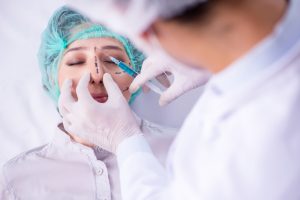People consider rhinoplasty for a number of reasons—sometimes it’s for a desired aesthetic change, sometimes it’s for structural repair from injury, and sometimes it’s for revision from another surgery. Whatever the reason, rhinoplasty is a complex plastic surgery and you should ask yourself the below 10 questions to help determine if you’re ready.
1—Do I Know What I Want?
Part of our process is to help you create a personalized facial profile to make informed decisions about what you want and what can be achieved with rhinoplasty. Dr. Matt Hershcovitch is a double board-certified plastic surgeon with extensive training and knowledge of facial aesthetics and nasal anatomy and will provide you with expert guidance–but you also shouldn’t be a completely blank slate. You should come to your first consultation with some ideas of what you do and don’t want, including bringing reference photos. This helps to have a starting point for the doctor to understand what aesthetics are important to you and he can make recommendations to guide you through all the considerations in order to select a final goal.
2—Are My Expectations Realistic?
If you’re considering rhinoplasty because you want to bring your nose into proportion with the rest of your features, it’s important to talk through your desired outcome with your surgeon to ensure your expectations are understood—and that they’re realistic.
Your “dream” nose may not actually be the best option for your individual face. It’s important to ask yourself if an aesthetic that you admire is actually one that fits in with your own features. There is no such thing as a nose that will look good on everyone. It’s important to take the time to scrutinize your different options and to choose the most pleasing shape for your face. Dr. Hershcovitch works with each patient to find the balance and harmony for a natural-looking, nuanced outcome that will fit their unique facial features.
3—Am I Ready For Permanent Change?
Make sure that you’ve given the decision enough thought—your nose is such a key part of the architecture of your face that reshaping it can change the entire balance and harmony of your features. This is often the goal of rhinoplasty and most people are very happy with new, more balanced features! But, as with any cosmetic surgery, make sure this is a decision that you’re doing for yourself after some appropriate reflection and without pressure from others.
4—Is This the Right Time to Get Rhinoplasty?
After surgery, you may experience some bleeding and drainage for a few days, and you’ll have specific post surgical instructions on how to reduce risks and promote better healing. This includes not using glasses on your nose for at least four weeks, as well as using extra sun protection and avoiding extreme facial expressions, strenuous activities, and exercise for several weeks. Talk to your surgeon about special activities, vacations, and your daily lifestyle to make sure you schedule your surgery at a good time to allow for proper recovery, healing, and the best results.
5—Am I Healthy Enough For Surgery?
We’ll go over your past medical history with you and assess your current health to make sure you are healthy enough to have surgery. It’s important to be honest with your care team about your medical history and medication use, among other considerations, in order to make sure an evaluation is accurate. There are risks with any surgery, so it’s also important to follow all your surgeon’s instructions to prepare for surgery and to take care of yourself after surgery.
6—Does My Surgeon Understand Both Form and Function?
If your planned procedure is primarily to address aesthetics, it’s still important to have a surgeon with an understanding of the complex anatomy of the nose, in order to minimize the risk of surgery causing or worsening breathing problems. Likewise, if your rhinoplasty is to address a deformity or structural problem from a traumatic injury or other cause, you’ll still want a surgeon skilled at cosmetic shaping since the nose is a defining feature of your appearance. Dr. Hershcovitch is an expert in both ENT (ear, nose, and throat) surgery and facial plastic surgery. As a double board-certified surgeon, Dr. Hershcovitch has extensive experience with facial surgical procedures, as well as the artistry to create natural-looking results.
7—Do I need Functional Rhinoplasty?
Skill with form and function are important for any rhinoplasty, but become especially important for those undergoing functional rhinoplasty. This type of procedure repairs a breathing problem while addressing cosmetic issues.
Cosmetic rhinoplasty can be combined with septoplasty, turbinate reduction, polyp removal, as well as nasal valve and nasal fracture repair. If you’re considering a cosmetic rhinoplasty and also have symptoms of nasal breathing obstruction—such as snoring, chronic sinus infections, nose bleeds, or pressure headaches—talk to Dr. Hershcovitch to see if you may benefit from a functional rhinoplasty. If structural problems in the nose need to be corrected for breathing problems, insurance may cover a large portion of a functional rhinoplasty.
 8—Do I know My Surgeon’s Track Record?
8—Do I know My Surgeon’s Track Record?
It’s your face—don’t take a risk. When looking for a surgeon, make sure to ask a lot of questions, including how many surgeries your doctor has performed and request to see before and after pictures of previous patients. Any reputable surgeon should be able to share this information with you to put your mind at ease. We’re happy to share more about Dr. Hershcovitch’s experience, technical ability, and patient testimonials so that you feel comfortable with your rhinoplasty surgeon choice. Feel free to check out our before and after rhinoplasty gallery.
9—Am I Open to the Best Surgical Approach for my Desired Results?
There are two different methods used for rhinoplasty: open and closed. In an open approach, the surgical incision is made in the columella (the tiny strip of skin on the bottom of the nose that divides the nostrils). In closed surgery, all incisions are made inside the nostrils, an approach that can mean less swelling, a quicker recovery, and no visible scarring.
Some patients are afraid that an open technique will lead to unwanted scarring, however open surgery is appropriate and the preferred method to achieve some kinds of reshaping results. Additionally, the incision used in an open technique is incredibly tiny and the scar from open surgery is only visible if someone is looking directly up the patient’s nose. It’s important to ask yourself if you’re open to the best technique depending on your nasal anatomy and aesthetic goals.
10—Does My Surgeon Have Experience With Nose Reshaping for Patients of My Ethnicity?
Each person’s face is unique and there are different standards of beauty across different backgrounds. It’s important to consider the experience of your surgeon in the context of your own ethnic background to ensure a nuanced, natural-looking, and aesthetically pleasing result. Dr. Hershcovitch has extensive experience with rhinoplasty for people of many different ethnic backgrounds and strives to make sure each patient’s goals are addressed appropriately.
Contact us today to learn more about rhinoplasty with Dr. Hershcovitch.


 8—Do I know My Surgeon’s Track Record?
8—Do I know My Surgeon’s Track Record?